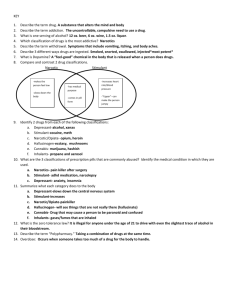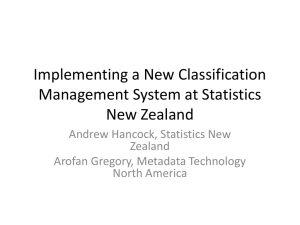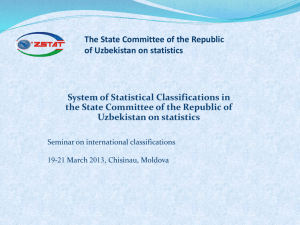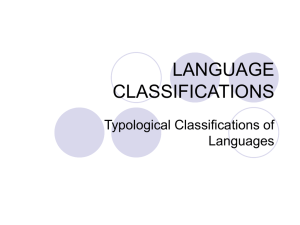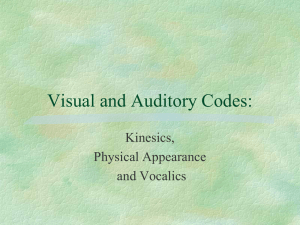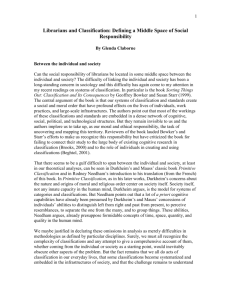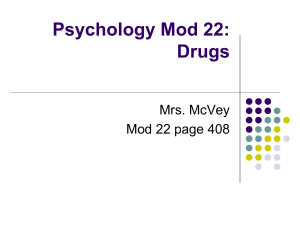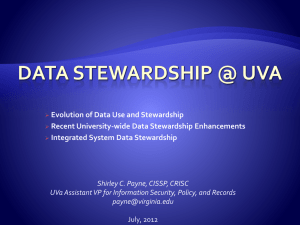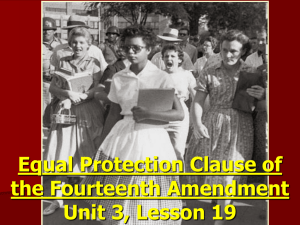Let`s talk about s … statistics
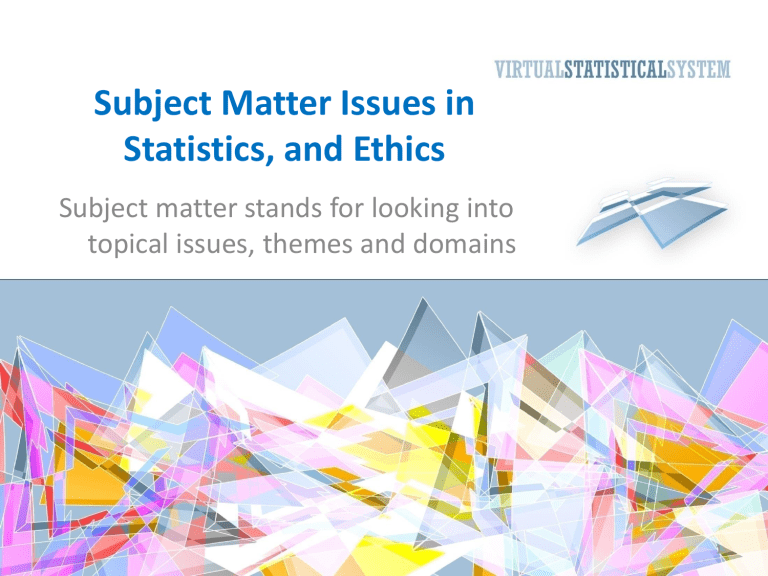
Subject Matter Issues in
Statistics, and Ethics
Subject matter stands for looking into topical issues, themes and domains
1
This lesson is about subjects
• Now we want to inform about how people influence statistics.
• The key words are subjects and subject matters and subjective.
• Subjective are views that are strongly influenced by the opinion of one person. It is a personal opinion.
• Inter-subjective is an opinion that is shared with many other persons/professionals.
2
The nature of subject matter issues
• Subject in the philosophical sense refers to a
(human) being that has subjective experience and consciousness. It is a word for humans, and for many other issues.
• Subject matter, in general, is anything which can be studied , described and analyzed.
• The nature of human(s) is to give meaning to their lives. A subject is expressing its own views by acting, behaving, or expressing opinions. This can also be called the inherent subjectivity of humans.
3
More on subject matters
• Subject also refers to an area of study or research. In research we can speak about the subjects that we study. That can be humans or other “subjects of interest”.
• The “subjects” and their behavior are normally the
“objects” of the statistical research.
• Another meaning for the word subject: subjects are those who are ruled by rulers.
4
The nature of objects
• Objects are no humans, they are things.
• These are mostly physical things that people (humans) move around.
• To complicate:
– An object can be a topic of study/research.
– Objects, as a topic for research, can become a subject matter for study purposes, when humans start to study it .
– And subjects can be also topics that can be studied.
• To summarize: When humans study a topic it becomes their subject matter issue.
5
The human subject’s behavior
• When humans travel they make use of the transport systems.
• Subjects decide the means of transport and how they use it: trains, directions, frequency and distances.
• When we measure the use of transport we look at what people are doing.
• Subject matter refers to a matter presented for consideration in discussion, thought or study.
• Other words for subject matters are topics, themes and domains.
6
People (subjects) make statistics
• Producing statistics is a work done by humans.
Therefore humans are always part of the outcomes of statistics, because they influence the results.
• In other words. The statistics you get are also the result of the humans that report about them and that work on them.
• That fact is influencing the quality of the source of the basic data.
7
We speak about subject matter and inter-subjectivity.
• Subject matters:
– When it is about humans (their characteristics)
– About their behaviors (labor, education, health)
– About the things they influence (production, nature)
– About the things they move around (goods, etc.)
• In science we speak about inter-subjectivity when a group of professionals come to the some conclusions.
– The more experts share conclusions the more we may assume that that opinion is correct. But that is not always true. Scientists need to stay alert.
8
How to define statistical topics
In the VSS we use a classification for the subject matter themes:
– Social and demographic.
– Economic statistics.
– Environment and Multi-Domain Statistics.
– Methodology.
– Strategy and Managerial issues of Official statistics.
9
How to classify subject matter issues
• When we define differences we do this on the basis of criteria.
• Experts can have different opinions about these criteria.
• Social and demographic is the behavior based on the actions of individuals and households.
• Economic behavior is mostly the behavior of enterprise units.
• Environment is the behavior of individuals and households and enterprise units and government that effect the environment.
• Multi-domain issues are a collection of topics that were not considered in one of the three groups above.
• Expert opinions can differ. Some see poverty as a social issue, other might see it as an economic issue. Therefore it is classified as a multi –domain issue.
• Classifications are extremely important, they exist in all themes on all subject matter topics.
10
Social statistics
• Social statistics are about individuals or households with regard to their actions, and what and how they do it.
• Time use is the most personal manner of acting.
• Different categories of work time use can be defined: paid and unpaid, formally and informally, unpaid for the own family, unpaid for friends and neighbors, unpaid for organizations.
• Other categories are personal time use, cooking and eating, etc.
• For each topic we need classifications in order to describe that type of behavior.
11
Classifications are key in statistics
• Before we make produce statistics we use classifications to categorize the population we want to describe, as well as its behavior.
• For demographics: age and sex are key.
• For education: types of schooling.
• For labor: types of professions.
• In economics the units (firms are classified by type of unit like economic activity and size).
• Other classifications are about products and trade.
• Each topic has its own set of classifications.
12
Use of classifications
• Classifications are used to analyze the populations. Therefore a combination of classifications are used.
• Classifications need to be based on some principles and criteria.
• Different classifications can be used to serve different purposes of research. For certain topics a range of classifications is used.
• When classifications need to be related to each other we speak about coordination.
13
Types of classifications and VSS.
• Economic activities.
• Products produced and services delivered.
• Products, goods and services traded.
• Types of government spending.
• Types of firms and changes of status of firms.
• Types of peoples and households.
• Types of education.
• Types of jobs.
14
Statistical Coordination
• Statistical coordination takes place within and between agencies.
• We have institutional and technical coordination.
• Government work in statistics is enhanced by the possibilities of information technology.
• And by structuring and harmonizing the content, methodologies, dissemination formats and documentation.
• One unit in the system needs to take the leadership role in the aspects of nationwide statistical coordination.
15
Institutional coordination
• Institutional coordination is needed to make sure that the various statistical units in own country are able to work together.
• This is reinforced by creating arrangements like stats councils, working groups and committees.
• The range of topics that need to be coordinated can even include international affairs. In that case a separate unit should be involved to coordinate these relations. Also in-country training needs coordination.
• Other form of coordination is the regional coordination between neighboring countries. (South-South)
16
Technical coordination
• Technical coordination is needed to make sure that the various products of the statistical system can be related to each other when needed.
• Technical coordination can best be addressed by subject matter working groups or other technical working groups.
• These groups can discuss the national and international standards that these units need to adhere to.
• They deal with concepts, methods, classification and technology.
• Especially around the National Accounts it is needed that all data that flows into the system is well coordinated and harmonized.
• Harmonization is making data fit to be compared and related to with other data.
17
Harmonized statistics
• Harmonization is the adjustment of differences and inconsistencies among different measurements , methods , procedures , schedules , specifications , or systems to make them uniform or mutually compatible.
• In statistics we adjust data sets to deal with inconsistencies for instance based on the use of different definitions or different units.
• In statistics we make data sets comparable so that they can relate to each other for accounting purposes.
18
System definitions
• (1) A set of detailed methods , procedures , and routines established or formulated to carry out a specific activity , perform a duty , or solve a problem .
• (2) An organized , purposeful structure regarded as a whole and consisting of interrelated and interdependent elements
( components , entities , factors , members , parts etc.). These elements continually influence one another (directly or indirectly) to maintain their activity and the existence of the system, in order to achieve the goal of the system.
19
Statistical system
• An organization of the relations between a well defined set of entities.
• An institutional statistical system is defined by the units that belong to the system and the relations that they have among each other.
• A conceptual system. All units that are described by the statistical and the relations that are defined between them.
20
Ethics in statistics
• Ethical behavior is human behavior per excellence.
• Statistics are based on trust. Trust is about believing that statements that are made are correct within the limits that exist.
• In statistics there are two kinds of trust. First, the trust with the providers of raw data that this information only will be used for statistical purposes.
• Second, the trust with the users that they can believe the correctness of the results, based on methods used and the meta data.
• Statistics is the treatment of data sets that may present only a portion of the population that it describes. The essence of statistics is making statements based on limited observations.
• Only image, skills and transparency can make that people trust that type of work.
21
Promoting trust with data providers
• Statistical organizations need to have legal frameworks that stipulate how these organizations have to behave when asking for data from data providers and using that data.
• Data needs to be treated in a very confidential way.
• Staff need to be faced with sanctions when there is a breach of these confidentiality rules.
• Confidentiality rules also apply to publication of the data. The data has to be anonymized.
• Individuals and firms should not be able to be identified as such in micro data sets and in tables.
22
Promoting trust with the users
• Products of statistical offices need to be trusted by the users, in order to be used.
• The trust should first of all be in the staff of the organizations.
• Staff should be skilled and trained to apply the methods that are expected to be used.
• Staff should demonstrate in their work that they master these skills.
In articles and publications.
• Staff should produce meta data which informs users about the key features of the data presented and the methods applied.
• Staff needs to be transparent in their work to a high degree.
• Lack of transparency, of skill and of image will lead to a lack of trust an a lack of funding.
• Lack of trust may harm statistics.
23
The underlying assumption on which trust is based
• Trust is based on the assumption that there is a truth that we can know and we should look for.
• This trust in the existence of truth is universal.
• When there is no truth possible there is no need to make statistics. Or we have biased statistics by definition.
• There is a truth in the natural sciences and in social sciences.
• We can learn more about this truth by applying the right methods. Methods learn us to approach the truth.
24
More on truth
• The truth only can be reached if we assume that all information collected is the correct information.
• Since humans provide information and can make errors and misreport for various reasons, we can only approach the truth.
• By definition in social statistics we can never be completely sure that we reach the absolute truth.
• The aim of the methods we apply is to come closer to the truth, knowing that we never can be certain.
• The methods we use have there own uncertainties.
Sampling has sampling errors and confidence intervals.
Sampling also has non sampling errors, because people err.
25
Truth and probabilities
• Even if we are not certain to reach the absolute truth, we can create evidence that makes it probable that we are approaching the truth.
• When we have a concept and we know that a feature exist we can look for the appropriate number.
• If no other methods exist people can make guesstimates.
• With methods we create evidence based information.
• When methods are correctly applied we create statistical facts.
26
Statistics and facts
• Facts are statements to be believed unless proven that these statements are wrong.
• Statistical statements are more like strong evidence than hard facts.
• That is why we speak of “evidence based”.
• Pure statistical statements can by definition be wrong.
• But most statistics should be considered to be the best possible approach towards the truth.
27
